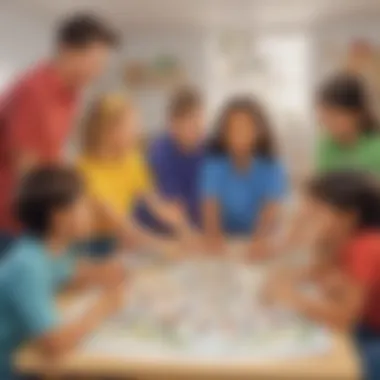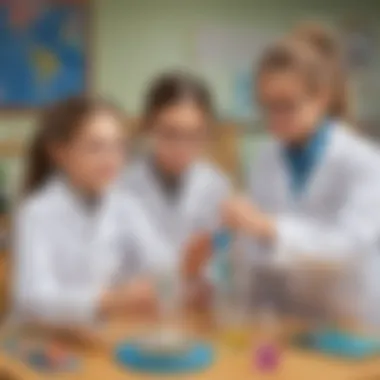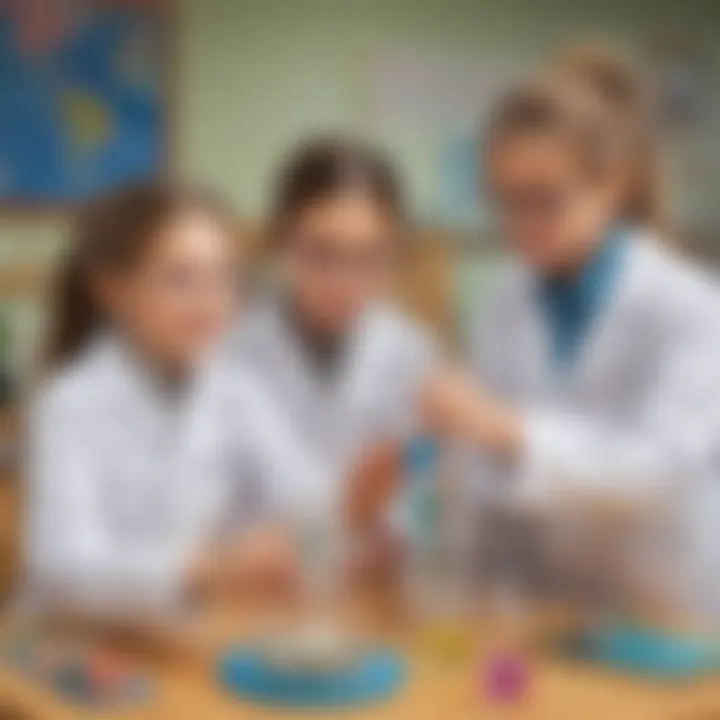Innovative Group Activities for Elementary Students


Intro
Engaging elementary students in group activities is essential for their development. Varied activities not only entertain the children, but also foster essential skills like social interaction, teamwork, and cognitive abilities. This article will delve into practical ideas to create innovative and fun group activities that are easily accessible for both educators and parents. By presenting a variety of category, from creative projects to interactive quizzes, the following sections aim to offer clear suggestions that align with the developmental needs of children aged five to twelve.
Creative Activities
Creative activities serve as a powerful means for young learners to express themselves while developing important skills. These activities encourage imagination and promote teamwork, reinforcing the significance of collaboration in a fun setting.
Craft Ideas
Creative crafts are ideal for hands-on learning. Children can connect with their peers while creating tangible projects. Some simple craft ideas include:
- Paper Mache Animals: By using layers of newspaper and glue, kids can create lively sculptures. This activity can enhance problem-solving skills when shaping different animal forms.
- Friendship Bracelets: Using colorful strings, students can learn the importance of giving and sharing through the act of making bracelets for each other. This promotes fine motor skills and creativity.
- Nature Collages: Collecting leaves, flowers, and other natural items can inspire students to engage with their environment while honing their creative thinking.
Step-by-Step Guides
Each crafted activity can benefit from structured guidance. Here is an example of a step-by-step approach for creating paper mache animals:
- Gather necessary materials (newspaper, glue, and balloons).
- Blow up the balloon to the desired size of the animal.
- Rip newspaper into strips and dip into a glue mixture.
- Cover the balloon with strips, letting it dry between layers.
- Once dry, pop the balloon and paint as desired.
Educational Value
Engaging in these creative activities has numerous educational benefits:
- Improves Fine Motor Skills: Crafting with scissors or other tools offers critical hand-eye coordination.
- Encourages Sharing and Teamwork: Children learn to work alongside their peers, thus enhancing social interactions.
- Stimulates Critical Thinking: Craft tasks require children to think through problems, encouraging cognitive development.
Fun Quizzes
Quizzes serve as an entertaining way to reinforce knowledge. They also enhance competitive spirit among children, which can be both engaging and educational. Fun quizzes can cover topics like science, mathematics, and literature, tailored for the elementary level.
Quiz Topics
Some relevant topics that may energize young minds include:
- Animal Habitats
- Basic Math Problems
- Story Character Analysis
Question Types
Variety in question types keeps quizzes interesting. Here are a few formats that work well:
- Multiple Choice Questions: Helps students to think critically while offering guided choices.
- True or False Questions: Engages children in broader knowledge examinations visually.
- Fill-in-the-Blank Questions: Enhances spelling and comprehension skills.
Knowledge Reinforcement
Using quizzes strategically aids in reinforcing what students learn in class. Forms of interactive learning such as these quizzes ensure deeper understanding while promoting active participation.
Fact-Based Articles
Fact-based articles provide valuable resource material that captures attention and is educational at the same time. By maintaining a clear and engaging approach, these articles empower children with knowledge.
Topics
The range of topics can include:
- Weather Patterns
- Historical Events
- Basic Biomes
Engaging Content
The articles strive to present information clearly and understandably. This method helps beginners grasp new concepts. Simple language and straightforward explanations keep focus and interest.
Understanding the Importance of Group Activities
Group activities play a pivotal role in the holistic development of elementary students. These activities not only provide enjoyment but also set the foundation for crucial life skills. When children engage in group settings, they encounter opportunities to collaborate, share, and negotiate, fostering their ability to work effectively with others. Furthermore, such experiences are key to supporting their natural curiosity and eagerness for learning.
Cognitive Development
Cognitive development refers to the process by which children grow in their ability to think, learn, and solve problems. Engaging in group activities encourages children to navigate complex challenges, enhancing their critical thinking skills. For instance, collaborative projects require them to plan, prioritize tasks, and allocate resources efficiently. Arguez studies suggest that interactive group tasks stimulate mental agility and creativity, as students discuss various strategies and viewpoints. Such discussions not only promote inquiry but also instill a sense of ownership over their learning.


Social Skills Enhancement
Participating in group activities is essential for students to refine their social skills. These experiences allow for the practice of communication, listening, and empathy. When children are asked to work in teams, they learn how to articulate their thoughts clearly and listen to the ideas of their peers. Sharing roles in a group helps develop respect for differing opinions and encourages negotiation. Additionally, failure and success within groups both serve as essential lessons, teaching important values such as collaboration and boundless inclusivity. Moreover, positive interactions can foster friendships that extend beyond school, directly contributing to their sense of belonging.
Emotional Growth
Emotional growth can often be intertwined with social interactions. Group activities act as a safe space for children to express their feelings, both positive and negative. The shared experience of teamwork promotes resilience through challenges, teaching students how to manage their emotions in various situations. During these activities, children can face small setbacks, which provide important learning moments. Over time, these experiences contribute to a strong emotional foundation, building self-confidence and encouraging an awareness of others' feelings. This nuanced understanding is essential in forming meaningful relationships and developing emotional intelligence—a skill that will benefit them not only in school but throughout their lives.
Key Takeaway: Group activities are instrumental in fostering cognitive, social, and emotional development in elementary students, equipping them with significant life skills for future success.
Types of Fun Group Activities
Group activities for elementary students offer significant benefits in both learning and social interaction. They serve to enhance cooperation, creativity, and allow exploration in a fun environment that supports development. It’s crucial not only to engage children but also to offer them experiences that meld enjoyment with educational value. The following sections underscore the value of various types of group activities, ranging from outdoor experiences to those held indoors or in virtual spaces.
Outdoor Activities
Outdoor activities considerably promote physical health while facilitating unique educational experiences. Children who engage in these types learn teamwork, communication, and build lasting friendships.
Team Sports
Team sports present a strong avenue for developing competitive spirit and collaboration among elementary students. Notable sports such as soccer and basketball involve strategies that require teamwork. The core characteristic here is the relatinship dynamics as children must cooperate to achieve common goals. These sports also enhance physical fitness, making them a visibly beneficial choice.
- Engaging in Team Sports can improve skills like communication, critical thinking and networking.
- Unique features include structured practices and competitions, which instill discipline.
- A potential disadvantage is that during competitive elements, some kids may feel overwhelmed or discouraged if they struggle significantly compared to peers.
Nature Scavenger Hunts
Nature scavenger hunts provide a perfect blend of education and adventure outdoors. One of the main reasons for its success as an activity lies in its ability to merge physical exploration with learning about the environment. Participants search for specific items or features in nature, driving curiosity and observational skills.
- Highlight in these hunts is the ability to operate in teams, promoting social bonds.
- A unique aspect, using custom-made lists, stimulates interest in diverse ecological facets.
- A downside could be potential distractions that easily arise in natural settings, requiring careful supervision to ensure focus and safety.
Obstacle Courses
Obstacle courses challenge students physically and mentally, teaching resilience and problem-solving techniques in a hands-on manner. They require navigation through various setups, offering an excellent medium for collaboration and strategy.
- The primary characteristic is that it encourages crystals of athletic skills while building a sense of achievement as children overcome hurdles.
- The design of every course allows for varying complexities, catering to different skill levels.
- However, the potentially physical and demanding nature may discourage less athletic children from participating actively, possibly leading to feelings of inadequacy.
Indoor Activities
Activities indoors are crucial when weather or safety doesn't permit outdoor engagement. They can yield the same cooperative spirit and cognitive challenges without relying on outdoor space.
Collaborative Art Projects
Art projects are enriching activities fostering creativity and teamwork. Children come together to brainstorm, plan, and execute, allowing them to glean from each other's talents while responding critically.
- One key characteristic is the aspect of expression that art offers, allowing students to convey messages while understanding others' points of views.
- Group projects bolster camaraderie, reflecting true collaboration in the art process.
- A unique challenge still exists; sometimes styles might clash, which may require guidance in navigating prioritized focus on the goal instead of individual artistry.
Board Games and Puzzles
Board games and puzzles have long been staples in educational group activities. They stimulate strategic thinking and following complex rules while developing patience and enjoyment. These activities also foster friendships through shared objectives and success.
- The crucial point here is strategic work combined with problem-solving with peers, which reinforces cognitive engagement.
- The interaction with challenging puzzles remains a captivating journey as students improve shared resources such as time and materials to solve them.
- Disadvantages include variability in players’ levels, leading to unequal participation where some children may feel left out or unsure how to contribute significantly.
Science Experiments
Involving students in science experiments provides compelling ways to engage them in group settings. They provide hands-on, interactive experiences that enhance observations and conclusions drawn from real-world applicability.
- Significant focus on inquiry-based learning resonates well with foundational scientific skills students can practice together.
- Unique features include conducting actual experiments, which creates an exciting atmosphere of discovery and surprise during execution.
- The comprehensive upfront guidance may be vital as lapses in understanding may result in less effective learning, calling for adequate educator's support.
Virtual Activities
Virtual activities extend the boundaries of engagement by allowing participation from home or various settings. They can include diverse educational tools, promoting collective learning & inclusive practices together.
Online Quizzes
Online quizzes serve as resourceful means to reinforce students’ knowledge in fun and competitive formats. In groups, children strengthen team communication while taking quizzes, often leading to lively interaction.
- One invaluable aspect is the engagement it brings through technology-driven stimuli in formats of multiple-choice or fill-in-the-blank questions.
- They can be tailored and increasingly inventive to fit curriculum needs strengthening learning concepts flexibly.
- However, accessibility issues to devices for some may complicate participation organically requiring attention to technological limitations.
Virtual Escape Rooms


Virtual escape rooms are an innovative solution to pushing problem-solving skills deeply. Children must solve mysteries and puzzles collaboratively within time constraints, fostering urgency and teamwork.
- Highlighted dependency on cooperation, makes every decision part of a subtle shared responsibility that lasts beyond virtual engagement.
- This unique environment of immersive challenges effectively bridges learning and excitement using interactive tech tools.
- Challenges arise from the need for shared tech fluency which all may not presently possess, risking varied generations’ interactions ranging.
Interactive Storytelling
Interactive storytelling blends narrative engagement with collective contribution on content, allowing elementary students to create stories together collaboratively. Mixing personalities helps with character development in real-time, playing off peers' ideas.
- One of the enriching factors in such activities is exploring empathy and adaptive communication as they invent tales reflecting different perspectives.
- A distinctive feature enables involved creativity among children enabling limitless story directions; drawing siblings or peers with shaping unitary vision often occurs.
- At times focus on divergent storytelling may obscure central lines which educators ought to consider closely.
Creating a Safe Group Environment
Creating a safe group environment is crucial for elementary students. This space enables children to engage freely in activities while feeling secure. When students know they are in a supportive environment, they are more likely to participate openly. They can express their thoughts without fear of criticism. This approach fosters a positive atmosphere where learning can thrive. A safe environment also allows children to form friendships. Strong social bonds enhance collaboration during group activities and encourage students to work towards common goals.
Establishing Ground Rules
Establishing ground rules is a foundational step in creating a secure environment. These rules outline expectations for behavior during group activities. Clear guidelines help students understand acceptable conduct, promoting a culture of respect. Without established rules, confusion may arise. Children might not know how to properly interact with peers. Ground rules can include guidelines regarding speaking turns, respect, and teamwork. When students agree upon these rules, it fosters a sense of ownership in the group dynamic. Regular reminders of these rules ensure that every member stays engaged and feels included. By incorporating their input in crafting these rules, students develop responsibility and commitment.
Encouraging Participation
Encouraging participation is vital to ensuring students feel part of the group. Each child should feel comfortable expressing their ideas without hesitation. Teachers or leaders should actively invite contributions from quieter students. This can be achieved through direct questions or allowing time for brainstorming together. Providing various roles during activities can help cater to different personality types. For instance, assign tasks like leader, note-taker, or timekeeper that appeal to a range of skills. Over time, this practice nurtures confidence in students. Remember, it's important not to pressure students into speaking. A gentle nudge is sometimes all that's needed for young learners.
Promoting Inclusivity
Promoting inclusivity within the group environment is essential. All students should feel they belong, regardless of backgrounds or abilities. Group activities can sometimes lead to cliques if not carefully managed. To combat this, consider mixing groups frequently. Rotate partners so that children have the chance to work with others. Introduce icebreakers that allow students to share something about themselves. This approach builds mutual respect among peers. Additionally, be vigilant against negative behaviors such as exclusion or bullying. Awareness and swift action help maintain a supportive environment. Fostering a culture of empathy and kindness further enhances camaraderie among students.
Fostering a safe group environment lays the groundwork for the most effective learning experiences.
Educational Benefits of Group Activities
Group activities are essential in education, especially for elementary students. They provide avenues for children to learn various skills beyond academic knowledge. Engaging in group activities helps children develop important competencies like critical thinking, teamwork, and problem-solving. Such skills are vital in today's interconnected world where collaboration is often key to success.
Through these structured group experiences, children not only enjoy the process of learning but also create lasting relationships that promote both personal and educational growth.
Critical Thinking Skills
Group activities encourage students to think deeply and critically about tasks at hand. When working with peers, children must analyze different opinions, weigh evidence, and construct reasoned arguments. This collaborative environment pushes them to consider diverse perspectives and develop their reasoning skills.
Furthermore, children are exposed to challenges that require them to think strategically. For instance:
- Participating in a team-based science experiment requires logic and predictive thinking.
- In collaborative art projects, they learn to critique their work and that of others constructively.
Through ongoing dialogue, they learn the value of debate and conviction. When children practice articulating their thoughts clearly, their confidence in critical thinking increases.
Teamwork and Collaboration
Building effective teamwork skills is clearer when students partake in group activities. Collaboration fosters a sense of unity among peers. It encourages children to rely on one another, which develops interdependence. Children realize their roles within a team. For instance, in a sports game, they learn that athletes have to function cohesively to achieve shared goals.
Incorporating teamwork in activities provides robust benefits:
- Develops communication skills. Team members learn to listen and articulate their thoughts.
- Builds negotiation strengths. Resolving differences within a team sets the tone for effective conflict resolution practices.
- Encourages sharing responsibilities, thereby reducing undue stress on individual members.
Through every collaborative effort, children grow as athletes and as thoughtful citizens.
Problem-Solving Capabilities
Group activities create platforms for students to tackle and solve problems jointly. Children face circumstance that require them to devise strategies and articulate solutions effectively. They learn that breakdowns can occur, however fixing them becomes a group effort, highlighting the value of every contribution.
When presented with challenges, children gain vital insights, such as:
- Balancing multiple viewpoints to reach consensus.
- Encouraging curiosity over frustration when facing obstacles.
- Refin balancing creative ideas with practical solutions.
Ultimately, these activities can stimulate intellectual maturity within children. As they navigate the complexities of collaborative problem-solving, they absorb lessons that will serve them for years to come.
“Through cooperative play, children develop not just skills but also the laughter and friendship that is foundational to life’s journey.”
Measuring Success of Group Activities
Evaluating the effectiveness of group activities is crucial in understanding their impact on elementary students. It provides insights into how activities foster cognitive growth, social interaction, and emotional development. By measuring success, teachers and parents can refine their approach to group engagements, ensuring these experiences remain beneficial and enjoyable for children.


Feedback from Participants
Collecting feedback from students after a group activity can yield valuable insights. Children can express their thoughts on which activities they enjoyed or which aspects they found challenging. It's essential to conduct these feedback sessions in a supportive atmosphere, allowing children to speak openly. Structured surveys or informal reflection sessions can be effective tools in this regard.
- Use simple questions like:
- What did you like about this activity?
- Was there anything you didn't enjoy?
- How did you feel while working with your peers?
This direct feedback can highlight specific areas of success and reveal any misunderstandings that occurred during the game. Adapting future activities based on input helps maintain engagement and relevance.
Observing Behavioral Changes
Observing student behavior during group activities can be another effective way to measure their success. Such observations allow adults to gauge collaboration levels, respect for peers, and emotional responses. Importantly, teachers should look for changes before and after activities.
Examples of behaviors to note include:
- Willingness to share ideas
- Ability to compromise during discussions
- Signs of frustration or disinterest
- New friendships that form based on group interactions
These behavioral indicators can suggest a successful outcome or identify areas that might require adjustments. For example, a notable increase in positive interactions can signal that the group activity was effective in achieving its interactive aim.
Assessing Learning Outcomes
Another significant aspect of measuring success in group activities is assessing the learning outcomes achieved. Activities designed with specific educational goals can be evaluated based on children’s performances post-engagement. Targeted assessments can be useful tools for this.
- For subject-centric activities, consider:
- Written quizzes relating to information learned from a specific activity.
- Group discussions to reflect on new concepts during science experiments or art projects.
When comparing students' understanding before and after group activities, it becomes clearer where they excelled and where further support may be needed. This approach ensures that activities are not just fun but effectively contribute to the children's educational journey.
Suggestions for Parents and Educators
Choosing suitable group activities can be a transformative encounter for both children and educators. It is essential to consider not only the fun aspects but also the educational value of each activity. The proper selection will ensure that children not only engage in play but también develop valuable teamwork and cognitive skills. Participation in group activities encourages shared experiences and builds stronger relationships among peers. Understanding how to navigate these choices benefits both children and groups as a whole.
Choosing the Right Activities
When selecting activities for groups of kids, aim to consider their interests and abilities. Not all children enjoy the same things, and it is crucial to find activities that fairly cater to different personalities. An appropriate starting point may include the following criteria:
- Interest Level: What do the children already enjoy or talk about?
- Skill Levels: Evaluate the skills and strengths of the group. Challenging yet achievable activities work wonder.
- Learning Goals: Consider the educational benefits. What social or cognitive aspects could be developed?
Brainstorming sessions can be an excellent way to allow the children to voice their preferences. Enlisting their input fosters a sense of belonging and increases engagement in the planned activity.
Adapting Activities for Age Groups
Children's developmental stages vary across an age spectrum, making it necessary to modify activities in ways that are appropriate for various groups. Here are tips for making adaptions based on age:
- Younger Kids (Ages 5-7): Simplify instructions and use vibrant objects like colored cones or toys to facilitate activities that emphasize motor skills.
- Middle Childhood (Ages 8-10): Introduce moderate complexity, adding quizzes or problem-solving tasks that promote constructive discourse and team collaboration.
- Older Children (Ages 11-12): Challenge them with intricate games that require strategic thinking and deeper group dynamics.
Using the same foundational activity, which could be a simple game like tag, offers the flexibility to adjust its format or rules as per age requirements.
Incorporating Technology
In our ever-evolving digital world, technology can be a productive ally in crafting engaging activities for young learners. Using technology effectively combines education with interactive fun. Consider how these strategies can be beneficial:
- Virtual Field Trips: Captivating audio-visual experiences can replace geographical limitations—expanded history lessons or cultural explorations become accessible. Websites like National Geographic offer exciting choices.
- Educational Apps: Applications specialized for children dominantly include games revolving around math, grammar or science which can nurture skills via enjoyable formats.
- Online Group Challenges: Websites like Kahoot enable child-friendly quizzes framed in a colorful layout.
Utilizing technologies properly allows groups from diverse backgrounds to interact meaningfully, lous off the true essence of collaborative learning.
By understaning how activities meet diverse needs, parents and educators stand in an advantageous position to help kids develop through playful learning.
Ending and Future Insights
The Evolving Nature of Group Activities
Group activities are continually changing as we learn more about child development and educational methodologies. In recent years, educators and parents have placed significant emphasis on collaborative learning. This approach values skills such as teamwork and communication over rote learning. Children's interests have also shifted with advances in technology and digital platforms. Embracing innovative platforms, educators can create engaging virtual activities. This becomes especially valuable when adapting to circumstances that limit physical gatherings.
Flexibility in activities is paramount. What works seamlessly for one group may not have the same effect on another due to varying interests, skills, and group dynamics. Thus, adaptability remains key in promoting fun group activities that resonate with elementary learners. The integration of cultural awareness and inclusive practices is vital as classrooms become more diverse. By valuing each student’s background, facilitators foster a more cooperative environment.
Encouragement for Lifelong Learning
Promoting the spirit of lifelong learning starts in elementary school. Group activities serve as pivotal catalysts for creating curious and engaged learners. Designing activities that encourage exploration stimulates creativity and intrinsic motivation.
This early exposure cultivates a sense of inquiry that students carry into adulthood. Participants actively take part in their learning process, shining a light on their unique interests and avenues for knowledge. Reinforcing the concept of continuous improvement resonates well beyond the school environment. These values ripple into their personal and future professional lives, highlighting the compelling link between enjoyment and education.quote Recognizing the essential role group activities play in shaping future learners is crucial. As students navigate various stages of their lives, maintaining a strong desire to learn tends to be tied to their early experiences in social setups.
To ensure the continued development of today’s elementary students into tomorrow’s proactive society members, educators and parents must champion ongoing dialogue and engagement. Selecting activities that cultivate passion and encourage teamwork offers the best groundwork for the growth of future learners.







